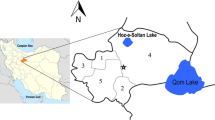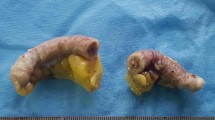Abstract
Purpose
Enterobius vermicularis might be seen in specimens of patients who underwent surgery due to acute appendicitis. There is still debate as to E. vermicularis infestation causes acute appendicitis. The primary aim of this study is to determine the incidence of E. vermicularis infestation, and the secondary aim is to determine the possible role of E. vermicularis in pathogenesis of appendicitis as well as the adequacy of demographic data and laboratory values in predicting infestation preoperatively.
Methods
A retrospective investigation was conducted with all patients who underwent appendectomy due to acute appendicitis in a secondary care center. Patients with E. vermicularis were compared with 24 controls that underwent appendectomy during the same time period. Demographic data, preoperative white blood cell (WBC) count, eosinophil counts, and histopathological findings for both groups were analyzed and compared.
Results
Enterobius vermicularis was detected in the appendectomy materials in 9 of 1446 patients (0.62 %). Histopathologically, only one of nine patients had acute appendicitis while the others were diagnosed with lymphoid hyperplasia. There were no statistically significant differences between the groups except WBC count. However, the WBC count was significantly (p < 0.05) lower in the group which was detected E. vermicularis.
Conclusions
Enterobius vermicularis is rarely associated with the histopathological findings of acute appendicitis. Also eosinophil count and elevation of white blood counts are inadequate for predicting preoperative E. vermicularis.



Similar content being viewed by others
References
Akbulut S, Tas M, Sogutcu N, Arikanoglu Z, Basbug M, Ulku A, et al. Unusual histopathological findings in appendectomy specimens: a retrospective analysis and literature review. World J Gastroenterol: WJG. 2011;17(15):1961–70. doi:10.3748/wjg.v17.i15.1961.
Yildirim S, Nursal TZ, Tarim A, Kayaselcuk F, Noyan T. A rare cause of acute appendicitis: parasitic infection. Scand J Infect Dis. 2005;37(10):757–9. doi:10.1080/00365540510012161.
Nackley AC, Nackley JJ II, Yeko TR, Gunasekaran S. Appendiceal Enterobius vermicularis infestation associated with right-sided chronic pelvic pain. JSLS: J Soc Laparoendosc Surg/Soc Laparoendosc Surg. 2004;8(2):171–3.
Wiebe BM. Appendicitis and Enterobius vermicularis. Scand J Gastroenterol. 1991;26(3):336–8.
Engin O, Calik S, Calik B, Yildirim M, Coskun G. Parasitic appendicitis from past to present in Turkey. Iran J Parasitol. 2010;5(3):57–63.
Yabanoglu H, Caliskan K, Ozgur Aytac H, Turk E, Karagulle E, Kayaselcuk F, et al. Unusual findings in appendectomy specimens of adults: retrospective analyses of 1466 patients and a review of literature. Iran Red Crescent Med J. 2014;16(2):e12931. doi:10.5812/ircmj.12931.
da Silva DF, da Silva RJ, da Silva MG, Sartorelli AC, Rodrigues MA. Parasitic infection of the appendix as a cause of acute appendicitis. Parasitol Res. 2007;102(1):99–102. doi:10.1007/s00436-007-0735-0.
Bredesen J, Falensteen Lauritzen A, Kristiansen VB, Sorensen C, Kjersgaard P. Appendicitis and enterobiasis in children. Acta Chir Scand. 1988;154(10):585–7.
Sodergren MH, Jethwa P, Wilkinson S, Kerwat R. Presenting features of Enterobius vermicularis in the vermiform appendix. Scand J Gastroenterol. 2009;44(4):457–61. doi:10.1080/00365520802624227.
Gialamas E, Papavramidis T, Michalopoulos N, Karayannopoulou G, Cheva A, Vasilaki O, et al. Enterobius vermicularis: a rare cause of appendicitis. Turkiye parazitolojii dergisi/Turkiye Parazitoloji Dernegi = Acta parasitologica Turcica/Turk Soc Parasitol. 2012;36(1):37–40. doi:10.5152/tpd.2012.09.
Isik B, Yilmaz M, Karadag N, Kahraman L, Sogutlu G, Yilmaz S, et al. Appendiceal Enterobius vermicularis infestation in adults. Int Surg. 2007;92(4):221–5.
Jones PF. Suspected acute appendicitis: trends in management over 30 years. Br J Surg. 2001;88(12):1570–7. doi:10.1046/j.0007-1323.2001.01910.x.
Butler C. Surgical pathology of acute appendicitis. Hum Pathol. 1981;12(10):870–8.
Kumar V, Abbas AK, Aster JC. Robbins and Cotran pathologic basis of disease. 9th ed. Philadelphia: Elsevier Saunders; 2015.
Petras RE, Gramlich TL. Vermiform appendix. In: Stacey EM, editor. Histology for pathologists. 3rd ed. Philadelphia: Lippincott Williams & Wilkins; 2007. p. 649–61.
Arca MJ, Gates RL, Groner JI, Hammond S, Caniano DA. Clinical manifestations of appendiceal pinworms in children: an institutional experience and a review of the literature. Pediatr Surg Int. 2004;20(5):372–5. doi:10.1007/s00383-004-1151-5.
Panidis S, Paramythiotis D, Panagiotou D, Batsis G, Salonikidis S, Kaloutsi V, et al. Acute appendicitis secondary to Enterobius vermicularis infection in a middle-aged man: a case report. J Med Case Rep. 2011;5(1):559. doi:10.1186/1752-1947-5-559.
Nathans AA, Merenstein H, Brown SS. Lymphoid hyperplasia of the appendix; clinical study. Pediatrics. 1953;12(5):516–24.
Gray GF Jr WP. Surgical pathology of the vermiform appendix. In: Sommers SC RP, Fechner RE, editor. Pathology annual part 2. Norwalk, CT: Appleton-Century-Croft; 1986. p. 111–144.
Deniz K, Sokmensuer LK, Sokmensuer C, Patiroglu TE. Significance of intraepithelial lymphocytes in appendix. Pathol Res Pract. 2007;203(10):731–5. doi:10.1016/j.prp.2007.07.003.
Aydin O. Incidental parasitic infestations in surgically removed appendices: a retrospective analysis. Diagn Pathol. 2007;2:16. doi:10.1186/1746-1596-2-16.
Clark PJ. Utility of eosinophilia as a diagnostic clue in lower abdominal pain in northern Australia: a retrospective case-control study. Intern Med J. 2008;38(4):278–80. doi:10.1111/j.1445-5994.2008.01644.x.
Acknowledgments
For this type of study any fund is not required.
Author information
Authors and Affiliations
Corresponding author
Ethics declarations
Conflict of interest
Nezih Akkapulu and Samir Abdullazade declare that they have no conflict of interest.
Ethical approval
For this type of study formal consent is not required.
Rights and permissions
About this article
Cite this article
Akkapulu, N., Abdullazade, S. Is Enterobius vermicularis infestation associated with acute appendicitis?. Eur J Trauma Emerg Surg 42, 465–470 (2016). https://doi.org/10.1007/s00068-015-0555-3
Received:
Accepted:
Published:
Issue Date:
DOI: https://doi.org/10.1007/s00068-015-0555-3




